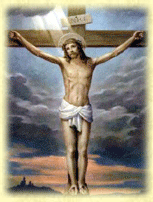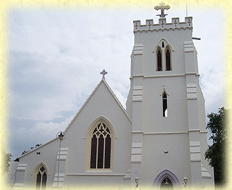|
 |
The Christianity ranks third in terms of religious affiliation after Hinduism and Islam. Today, the churches can be found in all the major towns of India. There are about 20 million Christians in India. The great majority of the Protestant Christians in India are now members of two broad groups of united denominations which are the Church of North India and the Church of South India. The Church of South India was formed from the major Protestant denominations in 1947, after the Church of North India in 1970. Both the churches account for approximately half of the total number of Christians. Roman Catholics form the majority of the other 50%. Various church congregations, both in the towns and villages are active centres of Christian worship. The majority of the Christian people use the local regional languages rather than English, which is typical of some of the larger city-based churches. |
Origin
Some of the churches in India belongs to the modern missionary movement of the late 18th century onwards or to the colonial presence of the European powers. However, Christians probably arrived in India during the 1st century after the birth of Christ. There is an evidence that one of Christ’s Apostles, Thomas, reached India in 52 AD, only twenty years after Christ was crucified. He settled in Malabar and then expanded his missionary work to China. It is widely believed that he was martyred in Tamil Nadu on his return to India in 72 AD, and was buried in Mylapore, in the suburbs of modern Madras. St. Thomas Mount, a small rocky hill just North of Madras airport is named after him. Today there is still a church of Thomas Christians in Kerala.
|
The Syrian Church
Kerala was linked directly with the Middle East, when Syrian Christians embarked on a major missionary movement in the 6th century AD. The Thomas Christians have a very different form of worship that showed very strong influence of the Syrian Church, and they still retain a Syriac order of service. They remained as a very close knit community, and maintained strict social rules very similar to those of the surrounding upper caste
Hindus as per the caste system. They lived in Kerala and trade with the Middle East that brought the Muslims back to the same region, some centuries later. |
 |
Roman Catholicism
The third major development took place with the arrival of the Portuguese. The Jesuit St. Franc Xavier landed in Goa in 1542, and in 1557 Goa was made an Archbishopric. Today, Goa bears rich testimony to the Portuguese influence on community life and on church building. They set up the first printing press in India in 1566 and began to print books in Tamil and other Dravidian languages by the end of the sixteenth century. The spread of Roman Catholicism was uneven, but was much stronger in the south. Jesuits concentrated their missionary efforts on work among the high caste Hindus, the most striking example of which was that of Robert de Nobili, who followed a Brahmin way of life in Madurai for many years.
Both the Roman Catholic and subsequently the Protestant denominations struggled to come to terms with the castle system. The Roman Catholic church tried to abolish the discrimination on the basis of the caste system, a pattern which the main Protestant communities tried to follow in the 19th century. The American Mission in Madurai instituted “agape meals” or “love feasts”, to which Christians of all castes were invited to eat meals together cooked by the members of low castes. The nature and the influence of Christian missionary activity in North India was different. There are very few Christians in North India than in the South, but Protestant missions in Bengal from the end of the eighteenth century had a profound influence on cultural and religious development. On November 9th 1793 the Baptist missionary William Carey reached the Hugli River. Although he went to India to preach, he was interested in language and education, and the work of 19th century missions rapidly widened to cover the educational and medical work as well.
Conversion can be made very easily among the backward castes and in the tribal areas. The Christian population in the tribal hill areas of Nagaland and Assam belongs to the late 19th century and 20th century movement. But the influence of Christian missions in education and medical work was greater than as proselytizing force. Education in Christian schools stimulated the reformist movement in Hinduism itself, and mission hospitals supplemented government run hospitals, particularly in remote rural areas, where they only offered the medical services. Some of these Christian-run hospitals, like at Vellore, provide high class medical care and as well as the Government run medical services.
Christian Beliefs
Christian theology had its roots in Judaism, that believe in one God, the eternal creator of the universe. Judaism viewed the Jewish people as the vehicle for God’s salvation the “chosen people of God”, and pointed to a time when God would send his Saviour or Messiah. Jesus, whom Christians believe was “the Christ” or Messiah, and was born in the village of Bethlehem, in Jerusalem. Very little is known of his early life except that he was brought up in a devour Jewish family. At the age of 29 or 30 he gathered a small group of followers and began to preach in the region between the Dead Sea and the Sea of Galilee. Two years later he was crucified in Jerusalem by the authorities on the charge of blasphemy – that he claimed to be the Son of God.
The Christians believed that all people live in a state of sin, in the sense that they are separated from God and fail to do his will. They believed that God is personal, “like a father”. As the god’s son, Jesus accepted the cost of that separation and sinfulness himself through his death on the cross. They also believed that the Jesus was raised from the dead on the third day after he was crucified, and appeared only to his close followers. They also believed that his spirit still continue to live today, and that he makes it possible for people to come back to God.
The New Testament of the Bible, which, alongside the Old Testament, is the text to which the Christians refer as the ultimate scriptural authority. It consists of four “Gospels” which mean good news, and a series of letters by several early Christians referring to the nature of the Christian life. |

